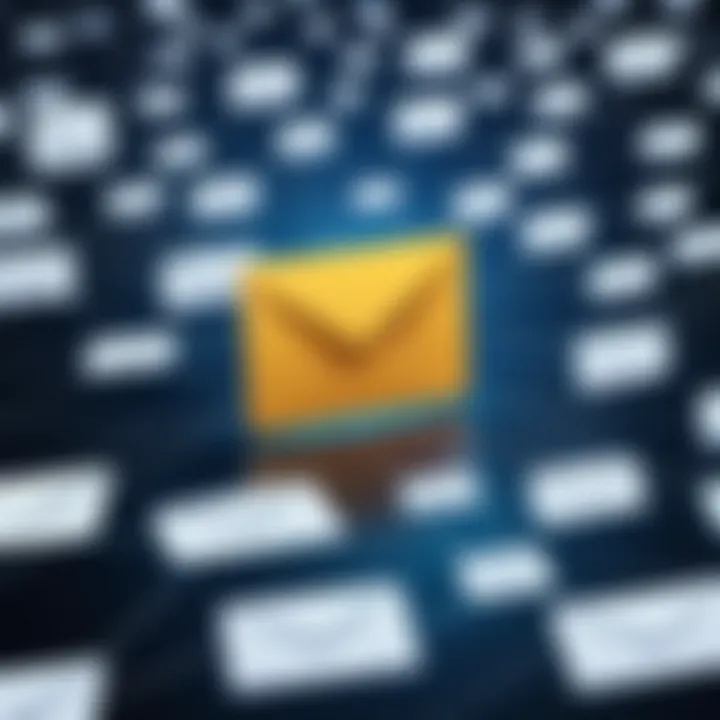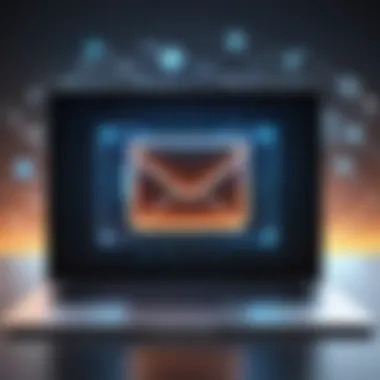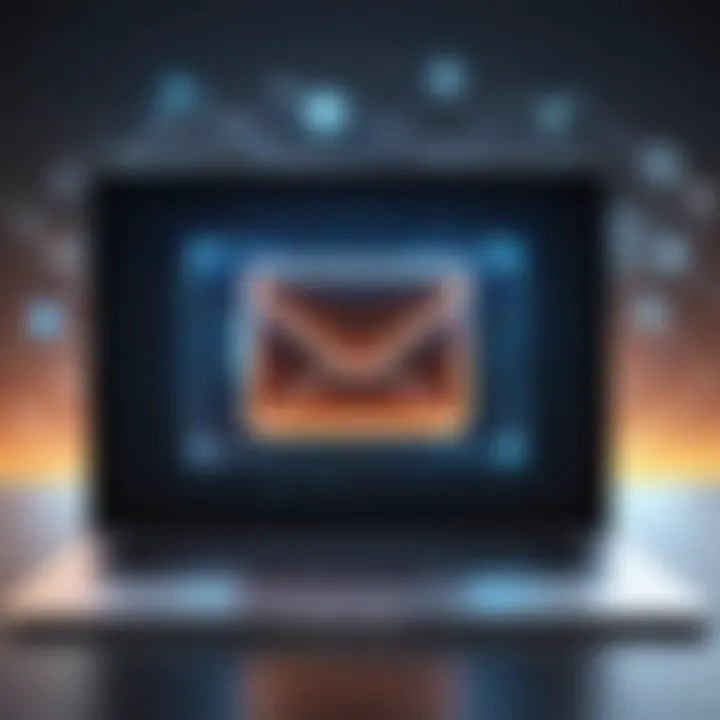Mastering Email: Strategies to Eradicate Spam


Intro
Spam emails have become a prevalent nuisance in today's digital age. They can not only clutter our inboxes but also pose significant risks to security and privacy. Understanding the nature of spam and implementing effective strategies to combat it is essential for every user. This article serves as a practical guide aimed at providing insights into the phenomenon of spam and methods to mitigate its impact.
Spam emails are often defined as unsolicited or irrelevant messages sent in bulk, typically for advertising or malicious purposes. These emails can lead to phishing attacks, identity theft, or financial loss. The need to address this issue is clear and pressing. As email continues to be a primary communication tool, reducing spam enhances productivity and contributes to a more secure online environment.
Having a clear grasp on strategies to eliminate spam is critical. This includes not only understanding how spam operates but also being aware of best practices for prevention and management. By adopting a proactive approach, users can protect their information and enjoy a cleaner, more organized email experience.
In the following sections, we will explore various effective strategies for managing spam. From utilizing filtered tools to understanding the importance of email security, these methods will empower users to take control of their inboxes. Let's delve deeper into the concepts relevant to storage, security, and networking, especially as they pertain to spam email management.
Understanding Spam Emails
Understanding spam emails is critical in today’s digital landscape. Spam can disrupt not only individual productivity but also organizational efficiency. When a user receives an abundance of spam, the important messages can be lost in the clutter. This leads to increased frustration and decreased work effectiveness. Furthermore, it is essential to grasp how various types of spam function and evolve. Grasping the nature of spam assists in better addressing and preventing its occurrence.
Definition of Spam Emails
Spam emails are generally unsolicited and often bulk messages sent to numerous recipients. They typically serve commercial purposes or seek to deceive users into providing personal information. The definition varies slightly on different platforms, but the essence remains. Recognizing spam emails early on can help mitigate the risks associated with them.
Types of Spam Emails
Understanding the different types of spam emails is crucial for addressing this issue effectively. Each category has its unique characteristics and impacts that users should be aware of.
Advertisements
Advertisements are promotional emails that often target consumers with offers for products or services. They frequently come from companies trying to market their goods. Despite the annoyance they can cause, advertisements are sometimes beneficial to users who may find value in the offers. The key characteristic of these emails is their intent to persuade the recipients to engage with the promotions.
Adverts can overwhelm your inbox, but they can also lead the way to potential savings if filtered correctly.
The disadvantage is that they can overwhelm inboxes, leading some users to mark them as spam without even considering their utility.
Phishing Attempts
Phishing attempts are malicious emails designed to trick users into revealing sensitive information. These emails often impersonate trusted entities, making them deceptive tools in the hands of cybercriminals. A significant aspect of phishing scams is their urgency, often creating a sense of panic in recipients. The most critical feature here is their intent to steal personal data. Phishing attempts contribute greatly to the overall issue by not only cluttering inboxes but also posing severe security threats.
Malware Distribution
Malware distribution involves sending emails that contain malicious software or links to harmful sites. These emails are particularly dangerous as they can lead to severe consequences for the user, including data loss or identity theft. One defining characteristic of this type of spam is the use of enticing subject lines designed to get the recipient to click on a link or open an attachment. The primary disadvantage is the potential harm to users’ systems and data privacy. Understanding this category is critical for anyone looking to maintain a secure digital environment.
The Impact of Spam Emails
Spam emails have a profound impact on individuals and organizations alike. They cost time and money, erode trust, and can lead to significant security vulnerabilities. In a world where email is a primary communication tool, understanding the consequences of spam is crucial. Recognizing the repercussions can help users adopt better email hygiene practices and invest in effective solutions to mitigate these problems.
Security Risks
One of the major concerns associated with spam emails is security. Spam can serve as a conduit for malicious software and phishing attempts designed to compromise personal and organizational data.
- Malware Infiltration: Many spam emails include attachments or links that, when opened, can install malware on users' devices. This can lead to data theft, unauthorized access to sensitive information, or even complete system failures.
- Phishing Schemes: Phishing attempts are prevalent in spam emails. Attackers often masquerade as trusted entities, tricking recipients into revealing login credentials or other sensitive information. For instance, a fake email from a bank asking to verify account details may seem legitimate, yet it’s a scam.
- Identity Theft: Once spammers gain access to sensitive information, they can use it for identity theft. This can cause long-term damage to victims, impacting credit scores and leading to financial loss.
Understanding these security risks is vital. By being aware of how spam operates, users can develop a more defensive posture against potential threats.
Productivity Loss
Spam emails do more than just pose security risks; they also significantly disrupt productivity. The time spent managing unwanted email can divert focus from important tasks.
- Time Consumption: Employees can waste a considerable amount of time sifting through spam to find legitimate emails. Studies have shown that workers can spend an average of 20 to 30 minutes a day dealing with spam. This cumulative time taken away from productive work can be substantial.
- Distraction Factor: Even if users have built-in filters, spam can still slip through. Each unfiltered spam email can be a distraction, pulling attention away from key projects and tasks. The constant interruption can lead to reduced effectiveness and increased frustration.
- System Slowdown: In some cases, a flooded inbox can slow down email systems. Large volumes of spam can consume bandwidth and processing power, leading to delays in communication.
Using resources efficiently is crucial. Recognizing the impact of spam on productivity can motivate users to implement robust strategies to minimize its presence in their inboxes.
Identifying Spam Emails
Identifying spam emails is a crucial skill in today's digital communication landscape. The ability to recognize unwanted messages ensures a more secure and efficient email experience. Understanding the characteristics of spam empowers users to take appropriate action, such as deleting or reporting these emails. The benefits of identifying spam include improved productivity and enhanced security, making users less vulnerable to phishing and malware threats.
Red Flags of Spam
Unusual Sender Addresses


Unusual sender addresses often serve as the first indication that an email may be spam. Many spam emails come from addresses that look odd, such as those containing misspellings or strange domain names. For example, an email from "support@paypa1.com" instead of "support@paypal.com" can signal a phishing attempt. This key characteristic helps users identify potentially harmful messages.
The unique feature of these unusual addresses is their ability to mimic legitimate ones while having subtle alterations. This makes it crucial for users to scrutinize sender details. Recognizing such patterns allows for a more proactive stance against spam.
Urgency in Language
Urgency in language is another common trait seen in spam emails. Phrases like "Act now!" or "Limited time offer!" often encourage hasty decisions, which can lead users to click unknowingly on malicious links. The urgency plays a significant role in manipulating recipients into reacting before they analyze the email properly.
This characteristic stands out because it targets human psychology, exploiting the fear of missing out. Spam messages frequently leverage this tactic to bypass user skepticism. Being aware of such language can prevent individuals from falling prey to scams.
Suspicious Links
Suspicious links are linked directly to the presence of spam. Emails that contain hyperlinks directing users to unknown or unrelated sites pose a significant risk. These links often appear legitimate but lead to fraudulent websites designed to steal personal information.
This notable feature can be both a trap and a safeguard for users. By hovering over the link without clicking, individuals can reveal the actual URL. This simple action helps users avoid potential data breaches or phishing attacks, allowing them to scrutinize emails before responding.
Legitimate Emails vs. Spam
Understanding the difference between legitimate emails and spam emails is paramount. Legitimate emails usually contain personalized content and come from recognizable sources. The appearance of a professional layout and correct grammar often indicates authenticity.
In contrast, spam emails often display generic greetings, poor language, and include numerous spelling errors. Recognizing these differences aids in efficiently filtering out unwanted messages. Users can apply these criteria when they receive new communications. Better awareness leads to a cleaner inbox and enhanced security.
Email Provider Tools
Email provider tools are essential for managing spam effectively. These built-in and user-configured features play a significant role in reducing unwanted emails, ensuring a cleaner inbox and enhancing security. Understanding how these tools work, their benefits, and practical applications helps users make informed decisions about their email management.
Built-in Spam Filters
Most email providers offer built-in spam filters as part of their service. These filters use algorithms to detect and divert spam emails to designated spam folders, helping users prioritize genuine emails. The effectiveness of built-in spam filters can vary between providers. Common features include keyword detection, machine learning capabilities, and user feedback mechanisms. Such filters continuously improve based on their observations and adjust to evolving spam tactics.
For instance, Gmail uses various techniques to classify emails, including user engagement data. If recipients frequently mark similar emails as spam, the filter adapts and accommodates those patterns, thus enhancing its accuracy over time. However, these filters are not infallible; occasional false positives can occur, where legitimate emails may end up in the spam folder. Users should frequently review their spam inbox to ensure no important messages are lost.
User-configured Filters
User-configured filters empower individuals to take control of their email experience. These filters allow users to set rules that determine how incoming emails are handled based on specific criteria. This customization adds a layer of personalization and effectiveness in managing spam.
Setting up Rules
Setting up rules involves defining parameters under which certain emails are filtered. Users can create rules based on sender email addresses, subject lines, or content type. This specific tailoring can significantly reduce irrelevant emails from cluttering the inbox. One key characteristic of setting up rules is its straightforwardness. Most email services guide users through a simple interface for creating and applying these filters.
A beneficial aspect of setting up rules is that it enhances overall email efficiency. For instance, automatically sorting newsletters or promotional emails into designated folders can free up the main inbox for more critical communications. However, users must regularly review and update these rules to ensure they remain relevant and effective, adapting to changes in email habits over time.
Custom Block Lists
Custom block lists provide another layer of protection against unwanted emails. Users can manually add specific email addresses or domains to their block list. This proactive approach is particularly effective against persistent spammers or fraudulent addresses. A key characteristic of custom block lists is their immediacy; once an address is blocked, emails from that sender are automatically diverted to spam or discarded.
The advantage of using a custom block list lies in the targeted prevention of unwanted emails from known spammers. This feature is popular among users who regularly experience problematic communications. However, a potential disadvantage is the need for periodic maintenance. Users must occasionally review their block list to remove any entries or add new ones, keeping the list relevant to ensure efficacy in spam management.
Using Third-party Applications
In the quest to reduce spam emails, utilizing third-party applications has become an essential strategy. These tools offer additional features that standard email providers often lack. They can automatically detect unwanted messages, filter them into separate folders, or block them entirely. This aids in maintaining a more organized and secure email experience. For individuals and organizations that receive high volumes of emails, these applications become indispensable.
Using third-party applications for spam filtering can lead to significant improvements in email management. They often employ advanced algorithms and machine learning techniques to identify spam more accurately than traditional filters. Users can frequently customize settings to suit their specific needs. Moreover, many of these tools offer reporting features that help track spam trends, which can inform better user practices and security policies.
However, one must consider the potential downsides. Relying on such applications may lead to a misconception of complete security. Users must stay vigilant, as no tool can guarantee 100% spam elimination. Furthermore, some third-party applications may require access to your personal data. It's crucial to choose reputable software to mitigate privacy risks.
Popular Spam Filter Tools
Several third-party spam filters have gained popularity due to their effectiveness. Tools like SpamAssassin, MailWasher, and Clean Email are widely preferred among users. Here’s a brief overview of each:
- SpamAssassin: A free, open-source tool that uses a variety of spam-detection techniques, including statistical analysis and rule-based checking.
- MailWasher: This application allows users to preview emails before they hit their inbox. It gives users control to delete or block unwanted messages directly from the server.
- Clean Email: A user-friendly option that helps organize mail and automatically filters out spam, newsletters, and promotional emails without much effort.
Each of these applications offers unique features, so evaluating options based on personal or organizational preferences is key.
Evaluating Application Efficacy


Determining the effectiveness of a spam filter application involves assessing several criteria. Firstly, accuracy in identifying spam is the most critical factor. Users should look for tools that boast high accuracy rates to minimize false positives and negatives. A reliable application should accurately filter a significant amount of unwanted emails while allowing legitimate messages to pass through.
User-friendliness is also essential. A good spam filter should have an intuitive interface that does not require extensive training to utilize. Integrated help and customer support can greatly enhance user experience.
Additionally, users should consider the application's update frequency. Spam tactics evolve constantly, and the software should receive regular updates to adapt to new threats. Users are also encouraged to seek testimonials and reviews on platforms like Reddit or Facebook to gauge performance from others' experiences.
"Choosing the right spam filter involves balancing effectiveness, usability, and privacy. Make informed decisions to protect your digital environment."
Best Practices for Email Management
Effective management of emails is essential in today's digital environment. By following best practices, one can significantly minimize the influx of spam emails while enhancing overall email security. These practices not only streamline your inbox but also contribute to better productivity. Maintaining an effective email management strategy enables users to quickly identify critical communications and avoid phishing attempts. Let’s explore two fundamental aspects of this topic: avoiding public disclosure of email and opting out of unwanted subscriptions.
Avoiding Public Disclosure of Email
One critical element in preventing spam is controlling how your email address is shared with the public. Publicly displaying your email can lead to it being harvested by spammers. This can include personal websites, forums, or even social media profiles. It's important to limit exposure by only providing your email address to trusted sources.
- Use Privacy Settings: Many platforms allow users to adjust privacy settings. Make sure these are set to limit who can see your email.
- Avoid Public Listings: When posting on online communities or directories, avoid listing your email openly.
- Create an Alias: Consider using a secondary email for public interactions, keeping your primary address private.
By practicing discretion, users can go a long way in protecting their inbox from unwanted messages.
Opting Out of Unwanted Subscriptions
Many spam emails come from subscriptions or newsletters that users may have signed up for either intentionally or accidentally. Unsubscribing from these sources is a vital step in managing unwanted emails. However, this process often requires diligence and awareness.
- Identify Sources: Regularly review emails in your inbox to identify subscriptions you do not read often.
- Use Unsubscribe Links: Legitimate companies generally provide an option to unsubscribe at the bottom of their emails. Make sure to utilize these links.
- Set Up Filters: Many email providers allow users to set up filters to automatically collect or delete unwanted newsletters or advertisements.
"Taking a proactive approach to managing subscriptions can drastically reduce clutter and improve your email experience."
Adhering to these best practices can lead to a cleaner email experience, thereby decreasing the chances of spam encroaching on your daily activities.
Maintaining a Clean Inbox
Maintaining a clean inbox is crucial in the ongoing battle against spam emails. A clutter-free inbox not only enhances productivity but also reduces the risk of overlooking important messages amid the noise of unwanted mail. It is essential to recognize that an organized inbox helps in managing time effectively; individuals can focus on pressing tasks rather than spending minutes or hours sifting through irrelevant emails.
One of the key elements of maintaining a clean inbox is regular email audits. This involves examining emails periodically to identify and remove or organize unnecessary clutter. By implementing this practice, users can significantly enhance their email experience and keep their inboxes manageable.
Another aspect to consider is the decision between archiving and deleting emails. Both actions serve to reduce the clutter, but each has its distinct purpose. Archiving can preserve emails needed for future reference, while deleting eliminates them altogether, which is suitable for transient communications or spam that is no longer relevant.
The benefits of having a clean inbox extend beyond mere aesthetics. Studies show that a well-maintained email system can improve psychological well-being by reducing stress associated with information overload. Therefore, creating a strategy to maintain a clean inbox is not just about organization; it reflects a broader effort to foster efficiency and mental clarity in one's digital life.
"A clean inbox is not just an organizational tool; it is a mindset that promotes clarity and focus."
By taking a proactive approach in maintaining a clean inbox through regular reviews, smart archiving practices, and decisive email management, one can keep spam at bay and ensure that essential communications are always within reach.
Enhancing Security Measures
Increasing the security surrounding email can be achieved through several specific strategies. One of the most effective is the implementation of two-factor authentication. This method adds an additional layer of protection by requiring a second form of verification beyond just a password. Moreover, utilizing strong passwords serves as a foundational element in enhancing security measures. Both elements are critical for creating a robust defense against spam emails and cyber threats.
Implementing Two-Factor Authentication
Two-factor authentication (2FA) offers an essential upgrade in security for email accounts. The standard practice of using a username and password is often insufficient against sophisticated cyber threats. With 2FA, even if someone manages to obtain these credentials, they would still need the second factor to gain access. This second factor may include a code sent to a mobile device or an authenticator app like Google Authenticator.
Using 2FA not only minimizes unauthorized access but also instills a greater sense of security for the user. Setting it up is generally straightforward: most email providers include this feature in their security settings. The process usually encompasses the following steps:
- Access the security settings of your email account.
- Enable two-factor authentication.
- Choose a method for receiving your codes (text message, authenticator app, etc.).
- Follow any additional prompts to complete the setup.
With 2FA, users can significantly decrease the chance of their email accounts being compromised, fostering a safer email environment overall.
Utilizing Strong Passwords
Passwords are the first line of defense against unwanted access to email accounts. However, many users tend to use weak or easily guessable passwords. This practice increases vulnerability to spam and phishing attacks. To counter this, it is crucial to utilize strong passwords that adhere to the following criteria:
- Minimum Length: A password should be at least 12 characters long.
- Complexity: Combining uppercase and lowercase letters, numbers, and special symbols can make passwords more effective.
- Uniqueness: Avoid reusing passwords across multiple accounts to decrease the risk of a widespread compromise.
Creating strong passwords can seem daunting, but several tools are available to assist users in this process. Password managers, like LastPass or Dashlane, can help generate and store strong passwords securely.


"A good password is like a solid lock on your door; it keeps out unwanted visitors."
Overall, enhancing security measures through two-factor authentication and the utilization of strong passwords forms a critical layer in the fight against spam emails. By employing these strategies, users can proactively secure their email accounts and mitigate the impacts of spam.
Education and Awareness
Education and awareness play a vital role in combatting spam emails. Although tools and filters do exist to block unwanted emails, knowledge empowers users to make informed decisions. It is not merely about relying on technology; understanding the nature of spam is crucial in staying ahead of the security threats that accompany it.
An educated user is more likely to recognize suspicious content or deceptive messaging. Recognizing potential threats mitigates risk, allowing individuals to avoid falling prey to scams such as phishing or malware distribution. By promoting awareness, organizations can create a safer digital environment for their employees and users alike.
Key elements of education and awareness in this context include:
- Recognizing the characteristics of spam emails: Users can be trained to identify common traits among spam, like unusual sender addresses or urgent requests.
- Understanding phishing scams: Increasing familiarity with how cybercriminals operate helps individuals question the validity of unexpected emails.
- Communicating best practices: Regular reminders about not disclosing personal information can reinforce safe emailing habits.
Incorporating these topics into training programs also has benefits. Employees who are educated about threats can contribute to a more secure workplace, reducing the likelihood of costly breaches.
"A well-informed user is an organization's first line of defense against spam and other cyber threats."
Overall, education and awareness act as critical tools in reducing the influx of spam, enabling users to handle their email with confidence and caution.
Understanding Phishing Scams
Phishing scams are among the most insidious forms of spam encountered today. These scams masquerade as legitimate communication from trusted entities, using social engineering to entice users into unveiling sensitive information. A common tactic involves emails that appear to come from reputable sources like banks or online services.
Users need to watch for telltale signs in these communications. For instance, generic greetings, errors in spelling, or inconsistent sender information often indicate fraudulent emails. Responding to requests for personal information or clicking on links from unverified sources can lead to dire consequences.
To bolster understanding, consider these points:
- Emphasize the importance of verification: Encourage individuals to check official websites directly instead of following links.
- Educate about the urgency tactic: Scammers often create a false sense of urgency to provoke hasty action. A well-timed reminder about this tactic can prevent lapses in judgment.
By instilling a thorough understanding of phishing tactics, users become better equipped to protect themselves from these malicious attempts.
Recognizing Fake Offers
Recognizing fake offers is essential for preventing email spam. Scams often include enticing offers that seem too good to be true. Consumers might receive emails promising large cash rewards, discounts, or exclusive access to products and services. These enticements aim to lure individuals into providing personal information or, even worse, paying money upfront.
To identify these fraudulent offers, users should consider several indicators:
- Unrealistic claims: Offers that promise significant gains with little or no investment tend to be scams.
- Lack of contact information: Reputable companies provide ways to reach their customer service or verify the offer.
- Poor language quality: Many scams originate from non-native speakers, leading to awkward phrasing and grammatical errors.
It is wise to approach such offers with skepticism and perform due diligence before taking any action. By being vigilant and informed, users can significantly reduce their risk of falling prey to these types of spam emails.
Legal Measures Against Spam
The legal framework surrounding spam emails is critical in the fight against unsolicited digital communication. Understanding and utilizing this framework can offer significant advantages for organizations and individuals alike. Effective legal measures against spam serve as a deterrent, penalizing those who engage in spamming practices and bolstering the overall integrity of email communication. This section examines the key aspects of anti-spam laws and the procedure for reporting spam incidents.
Understanding Anti-spam Laws
Anti-spam laws vary across different regions but generally aim to create a safer environment for email communication. In the United States, the CAN-SPAM Act of 2003 is one of the most recognized regulations. It sets forth guidelines for commercial emails, requiring spammers to include a clear opt-out mechanism and accurate sender information.
In the European Union, the General Data Protection Regulation (GDPR) plays a significant role. It mandates consent from users before their data can be collected or used for marketing purposes. This heightened standard emphasizes personal privacy, increasing the accountability of email marketers.
The benefits of adhering to anti-spam laws include:
- Legal Protection: Complies with laws to avoid actions against you.
- Enhanced Reputation: Builds trust with users and improves brand perception.
- User Engagement: Encourages responsible communication practices.
Failing to comply with these laws can lead to stiff penalties, including hefty fines and legal action. The need for companies to stay informed about these regulations is paramount.
Reporting Spam to Authorities
Reporting spam can often seem like an underutilized action, yet it is an essential aspect of mitigating its prevalence. Individuals and organizations can report spam emails to authorities, which contributes to a broader effort in combating such nuisances.
In the United States, the Federal Trade Commission (FTC) accepts reports related to spam. Citizens can forward unwanted emails that violate the CAN-SPAM Act directly to the FTC's complaints database. Similarly, in the UK, individuals can report spam to the Information Commissioner’s Office (ICO).
The process usually involves:
- Collecting evidence, such as screenshots or the email itself.
- Noting the sender's details and any identifying information about the spam message.
- Using relevant online forms provided by agencies like the FTC.
"By reporting spam, individuals play a crucial role in enforcing rules and helping to reduce the intrusion of unwanted emails in everyone’s inbox."
While reporting spam may seem a small act, it drives accountability and creates a collaborative environment where tech companies and users can work together to reduce spam activities.
Utilizing legal measures against spam not only protects against unwanted communication but also fosters a safer digital ecosystem.



